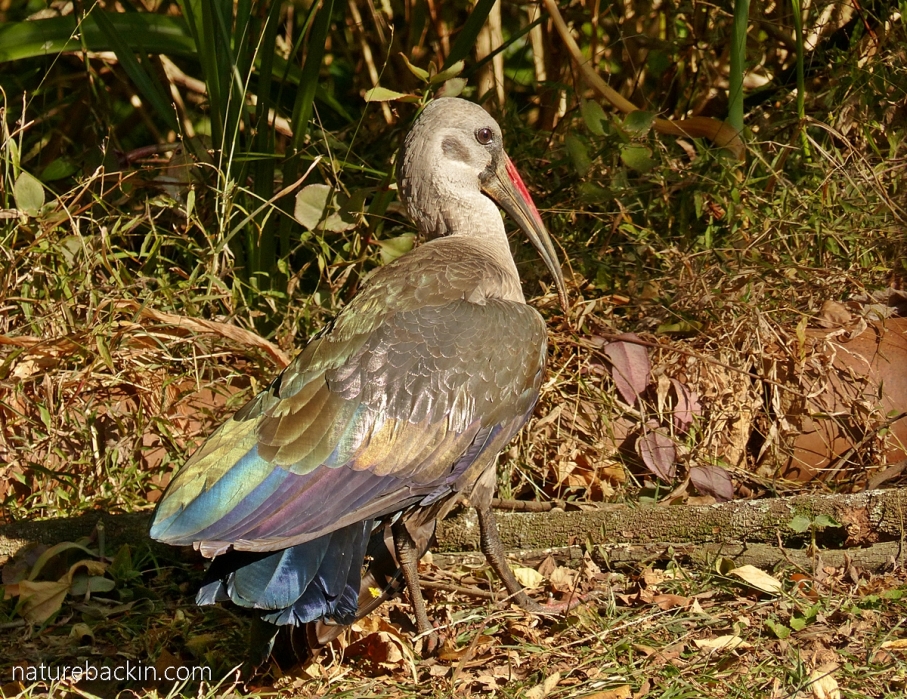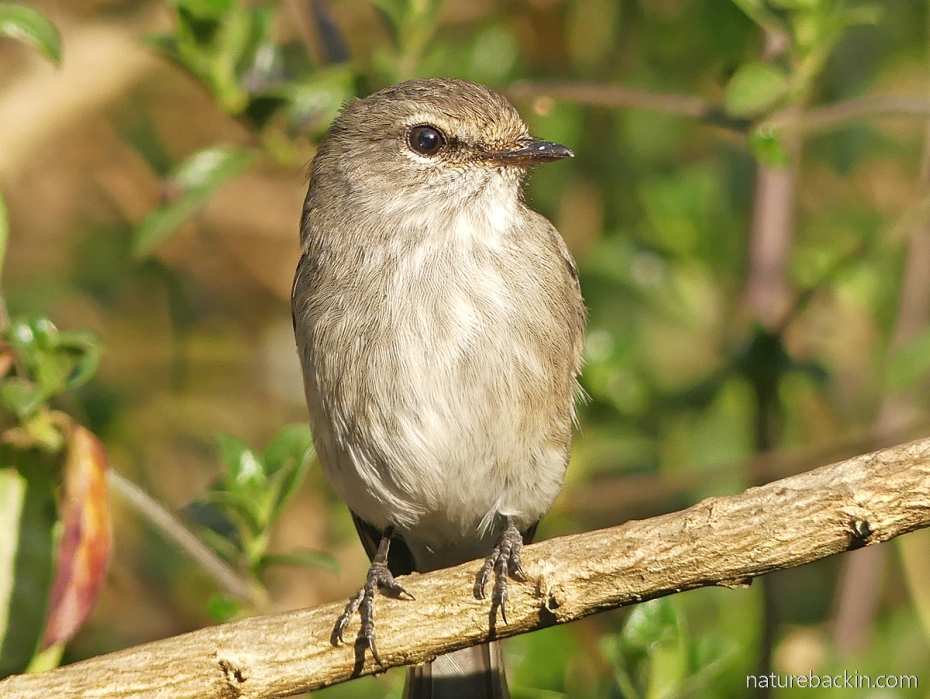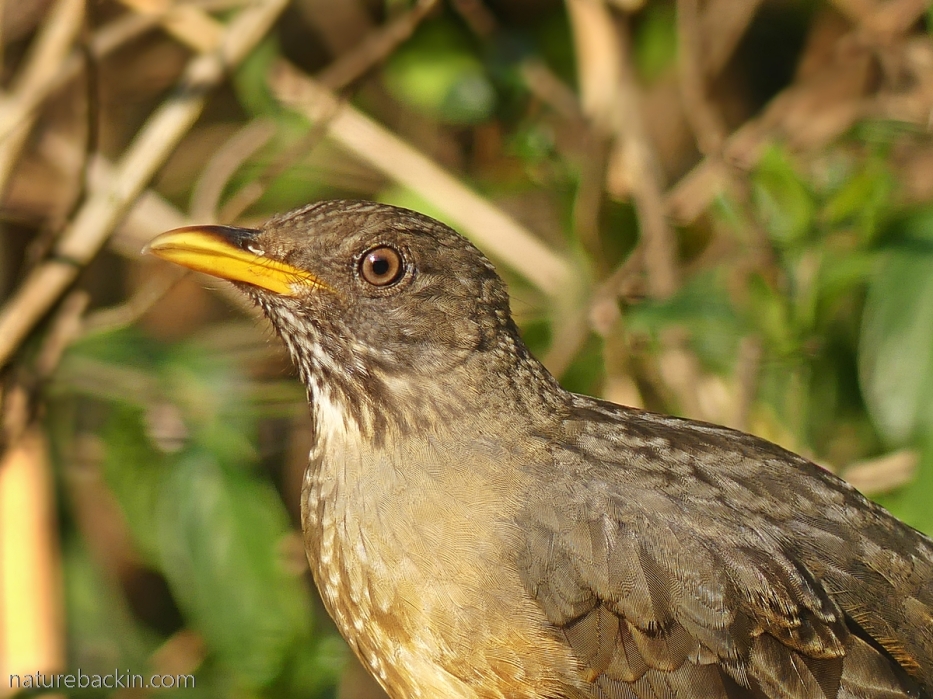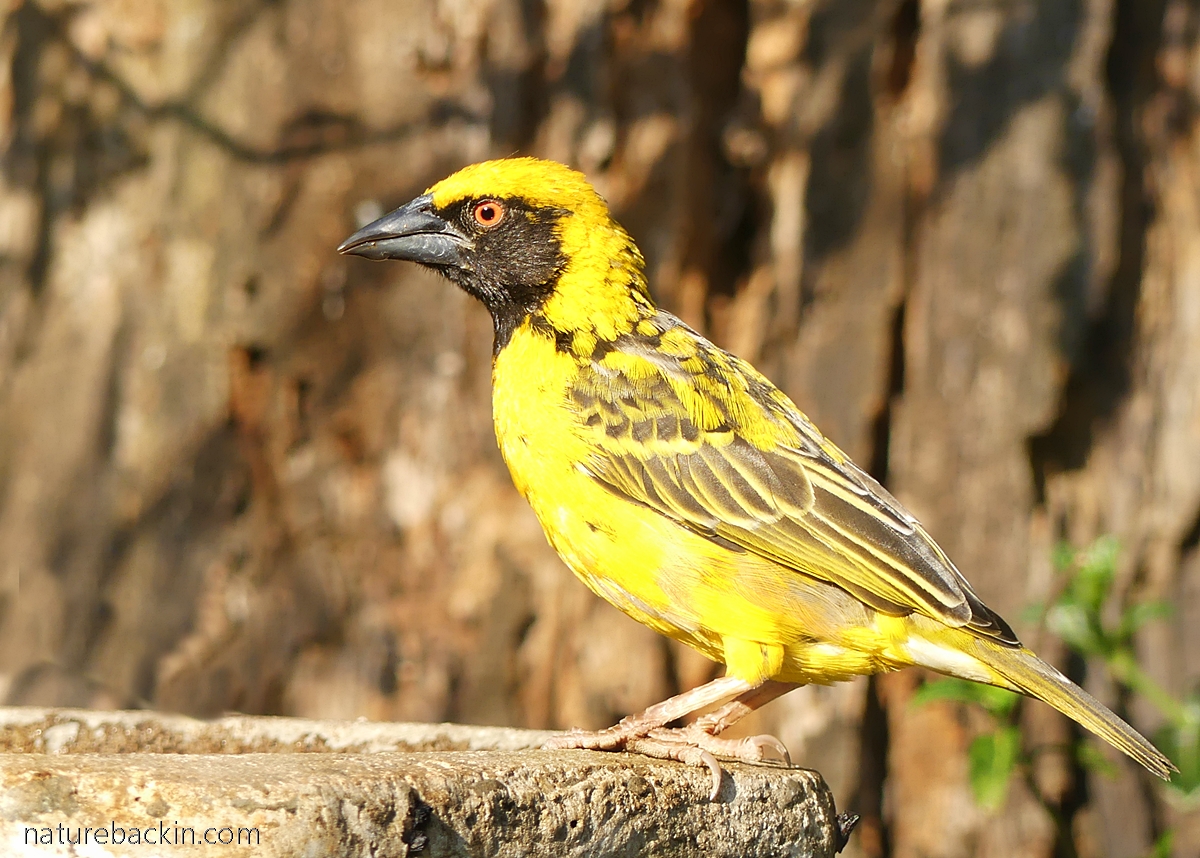After last week’s post on doves, I thought I’d share some bird pics taken in the garden over the past year or so. This is an entirely random and not at all representative selection.
The bright header photo is of a village weaver (Ploceus cucullatus) at the bird bath illuminated by morning sunshine. Most years, village weavers come and build nests in our fever trees, not that they ever seem to use the nests for actually breeding, but this year they gave nest building here a miss and have only been visiting fleetingly.

Among the most regular avian visitors are dark-capped bulbuls (Pycnonotus tricolor). They usually visit in pairs and sometimes in small family groups and are generally very vocal with a loud chirping call that sounds cheerful to human ears. The yellow rump and small crest on the head are distinctive.

I have showcased before the odd postures of hadeda ibisis (Bostrychia hagedash) sunbathing with their wings outspread. As the one in the above photo is in the process of folding in its wings and stepping forward after sunbathing, the light catches on its feathers showing their colourful iridescence.

I had to lurk some distance away to catch this photo of a Cape robin-chat (Cossypha caffra) taking a bath. They make a thorough job of bathing, frequently dunking their heads under water while they lift their wings slightly and fan their tails.

The grey cuckooshrike (Coracina caesia) can be hard to see (and hard to photograph) as it forages high up in the tree canopies, but its presence can be given away by its high-pitched drawn out call. The whitish ring around the eye gives it a slightly odd appearance. Cuckooshrikes are neither cuckoos nor shrikes, although some may slightly resemble cuckoos in appearance.

Like most thrushes the Kurrichane thrush (Turdus libonyanus) is a ground forager, running short distances and then stopping and apparently listening and sometimes searching for food rather noisily by energetically flicking leaves aside with its bill. This one paused a moment to inspect me as I took this photograph. I was sitting on the ground some distance away and it tolerated my presence as long as I kept as still as possible.

I quite like this photo of a forest canary (Crithagra scotops) as it reflects their preference for foraging in denser vegetation. Their natural habitat includes forest patches and coastal thicket but they have adapted to other well-wooded areas such as gardens that meet their requirements and the margins of plantations.

The small African dusky flycatcher (Muscicapa adusta) is a quiet presence in the garden. I only see solitary birds – apart from once when I saw a parent bird feeding fledgling chicks. I often see one perched on a tree branch waiting to hawk insects flying by and I also see individuals visiting the bird bath.

The olive thrush (Turdus olivaceus) is slightly larger than the Kurrichane thrush and it prefers denser more forested habitats than the kurrichane. However, their ranges do overlap in modified environments such as gardens where the vegetation is suitable for both species.
As autumn approaches more birds are visiting our garden, perhaps attracted by plants going to seed or by insects. Many insects are more evident at this time of the year, particularly butterflies. Despite it heralding winter, autumn is a lovely time of the year.

Posted by Carol









March 5, 2021 at 2:42 pm
What a treasure trove these African garden birds are to those of us who don’t live in Africa. Great photos and info about each one, Carol, thank you. I was especially dazzled by the hadeda ibisis.
LikeLiked by 1 person
March 5, 2021 at 6:10 pm
Thanks Jet – we are lucky to have so many gorgeous bird visitors. The hadedas can be dazzling when the light catches the iridescence at just the right angle.
LikeLiked by 1 person
March 4, 2021 at 3:09 am
Greetings Carol! How I enjoyed seeing those birds! What a fabulous variety! Here in Massachusetts, I look forward to seeing the birds settling in as he weather gets warmer, but we have a few weeks to go yet.
LikeLiked by 1 person
March 4, 2021 at 7:20 pm
Thank you Julie. Good to hear from you and I hope you are well? How nice that you have springtime to look forward to!
LikeLike
March 4, 2021 at 9:25 pm
Thanks! I am well. I’ve spent a few months focusing on other artistic endeavors, but I have missed WordPress. Looking forward to a better Summer than the last one!
LikeLiked by 1 person
March 4, 2021 at 9:31 pm
Good to know that all is well. Sending good wishes for a much more hopeful summer this year than last year. Here of course we are heading into autumn …
LikeLike
February 28, 2021 at 4:21 pm
What a lovely collection of visitors. It’s hard to imagine Africa and Asia without bulbuls – I’ve enjoyed watching the yellow-vented species in Singapore and the Philippines.
That weaver is a stunning colour, and so is the hue in the ibis’ feathers.
LikeLiked by 1 person
February 28, 2021 at 7:26 pm
Thanks Adele – I have just been browsing through images of Asian bulbuls – I had been unaware there are so many species there. There are so many variations although with much in common.
LikeLiked by 1 person
February 25, 2021 at 7:46 pm
Gorgeous photos Carol! You have captured the birds so clearly. Isn’t it funny how one can miss the calls of those Hadeda’s? I do. The little Cape robin-chat are lovely little birds too, and another favourite of mine. I enjoyed your post!
LikeLiked by 1 person
February 27, 2021 at 2:07 pm
Thanks so much. I know that many people don’t like the loud calls of the hadedas but I have very pleasant associations with their calls and I can understand how you miss them! There is something particularly endearing about the Cape robin-chats.
LikeLiked by 1 person
February 25, 2021 at 4:25 am
Dear Carol, I’ve never seen a grey cuckooshrike, so lovely! The rest I enjoy seeing here on a daily basis, so enjoyed your beautiful captures! xxx
LikeLiked by 1 person
February 27, 2021 at 2:06 pm
Thanks Christeen 🙂
LikeLiked by 1 person
February 20, 2021 at 3:19 am
Hello Carol,
Nature never seems to fail to uplift our spirits with our avian friends. Thank you for sharing these visitors, I hope you and all your dear ones are staying safe and well.
LikeLiked by 1 person
February 20, 2021 at 2:59 pm
It is so true Takami that having birds around really is uplifting, and it is hard to imagine what it would be like without their vibrant presence and beauty.
We are fine thanks and I hope that you and yours remain so too. Sending best wishes.
LikeLiked by 1 person
February 19, 2021 at 12:35 pm
Lovely. Most I have in my garden but a couple I don’t. Nice to see the different ones
LikeLiked by 1 person
February 20, 2021 at 2:57 pm
Thanks Ark. Life would be so diminished without the visiting birds that add such vivid life to our spaces.
LikeLiked by 1 person
February 20, 2021 at 3:07 pm
How many have you recorded to date?
Do you keep records of your avian visitors?
LikeLiked by 1 person
February 27, 2021 at 1:39 pm
Hi Ark – apologies for the delay in replying. A major and urgent DIY project took over and then after that we had no Internet for 3 days. Mostly back on course now thank goodness.
Re birds – we do have a list of birds we have spotted in and from the garden, so that includes the occasional fish eagle flying overhead! It also includes birds that we have only noticed visiting only once or twice. I need to relook at the list and see if there is anything to add, but last time we did that it numbered just over 70 species. I keep thinking I should keep a list of monthly sightings but I have never got around to it.
Do you keep records or at least a tally?
LikeLiked by 1 person
February 27, 2021 at 3:27 pm
I have photographic records going back to 2015 when I started, a few records of solely visual sightings ( when I couldn’t get to my camera in time!)Like you, I include overhead sightings as well.
To date, photographs of 53 confirmed species.
We had a single visit from a Hammerkop about four years ago, and a touch down and take off by an Egret last month.
My daughter recently saw an African paradise flycatcher in one of the Acacia trees in the front garden so we’ve added this ti the list.
LikeLiked by 1 person
February 27, 2021 at 7:38 pm
I also tend to rely more on my photos than on making lists. Your record of 53 photographed species sounds remarkable esp for a relatively highly urbanised Jhb?
That is exciting to have a Hammerkop visit,
Decades ago Egrets used to be common here, but I don’t see them here now. But on the other hand we now have resident Purple-Crested Loeries – they used to be more of a coastal species I believe.
I do hope you see the paradise flycatcher again – they are intermittent visitors here and always lovely to see.
LikeLike
February 27, 2021 at 8:13 pm
Our pool is used as a koi pond and we used to have a couple of wooden logs spanning the pond. One morning I stepped out onto the stoep and there was the Hammerkop, walking across one of the logs! I couldn’t believe it. The next moment it took flight.
We are close to Observatory golf course , so I think such a large green space must be home to a fair number of these birds.
Houghton golf course is a few ks up the road and they have a lot more species than I do … a LOT!
I had a slide show up on my blog a while back of all the visitors but I think I took it down because I ran out of space. Maybe I should update it and do a new one?
I try to plant for ‘birds and bees, hoping that this helps and I also keep monthly photographic records as well. It’s interesting … and sometimes a concern when avian visitors are absent.
I hope we see the paradise flycatcher again. My daughter was over the moon even though it was only a brief glimpse.
LikeLiked by 1 person
February 27, 2021 at 9:17 pm
I guess the Hammerkop was hoping to do a spot of fishing?
Nice to know that golf courses do provide for some species at least.
Planting for the birds and the bees (and not using pesticides) definitely does bring bird visitors. I also worry when certain birds are absent – this summer there have been far fewer thrushes. I use my photo archve to check up on the month/season when a photo was taken but it is an unsystematic and cumbersome way of checking. So I really should start keeping a monthly record – it may well yield some interesting patterns. Thanks for prompting me to give it more serious thought!
LikeLike
February 19, 2021 at 12:03 pm
So lovely! We have some of the above right now in abundance in our Johannesburg garden: The hadeda, olive thrush, cape robin, bulbul and yellow weaver. Nice to see them here on camera!
LikeLiked by 1 person
February 20, 2021 at 2:55 pm
Thank you! Aren’t we lucky to have so many lovely visiting birds to enjoy?
LikeLiked by 1 person
February 24, 2021 at 10:09 am
We are. Something to appreciate every single day
LikeLiked by 1 person
February 27, 2021 at 2:05 pm
Absolutely!
LikeLiked by 1 person
February 19, 2021 at 10:10 am
Birds in the suburbs bring much pleasure. Thanks for the beautiful photographs. We see many of the same birds as you and my annual highlight is when the paradise flycatcher returns to this area.
LikeLiked by 1 person
February 20, 2021 at 2:51 pm
Thanks Mariss. I also love it when the beaugiful paradise flycatcher visits. They are so flighty I find them difficult to photograph though,
LikeLike
February 20, 2021 at 3:40 pm
I can imagine. It’s even hard to keep them in sight as they flit about.
LikeLiked by 1 person
February 27, 2021 at 1:39 pm
True!
LikeLike
February 19, 2021 at 9:13 am
Oh, I love the fifteen minutes of fame you’ve given to all these birds! And not a single one is familiar to us here in the UK, which makes this even more exciting. I was going to pick a favourite. Can’t be done.
LikeLiked by 1 person
February 20, 2021 at 2:50 pm
Thanks Margaret. Btw, the Kurrichane thrush has a song that is similar (if not quite as pretty) as the English blackbird, if my memory serves me correctly. I recall being quite surprised when I learned that the blackbird is a thrush!
LikeLiked by 1 person
February 20, 2021 at 5:00 pm
I know! We all think of it as being supremely itself.
LikeLiked by 1 person
February 27, 2021 at 1:41 pm
That is very true and well put!
LikeLiked by 1 person
February 19, 2021 at 6:17 am
I would love to spend time in your garden – your excellent photographs made me feel quite at home! There has been very little in the way of weaver nest building here too and none of the nests have been occupied. They are obviously nesting somewhere close for there are a number of weaver youngsters (especially the Southern Masked Weavers) being fed in my garden. It is years since I spotted an African Dusky Flycatcher here, so I was delighted to see your photograph of one.
LikeLiked by 1 person
February 20, 2021 at 2:43 pm
I am sure you would feel at home here Anne 🙂 It is good to know that the weavers visiting your garden are successfully raising young from nesting somewhere nearby.
I hope you spot a visiting African dusky flycatcher visiting again one of these days.
LikeLike
February 19, 2021 at 4:11 am
Great photos. I’m envious of the variety of birds visiting your garden. The village weaver is a real stunner.
LikeLiked by 1 person
February 19, 2021 at 2:30 am
Excellent photographs, Carol, of beautiful birds. Your patience was well rewarded and I take it as a thanks from the birds for your efforts to make your piece of suburbia a haven for them.
LikeLiked by 2 people
February 20, 2021 at 2:37 pm
Thanks so much. Although there are always birds around, more birds seem to make the most of the garden in autumn and winter – perhaps they find bounty more readily elsewhere during the summer months? Although we provide water in several bird baths, we seldom use a bird feeder and so the food available in the garden is from the plants, which are mostly indigenous, and of course from the insects and other critters that are around.
LikeLiked by 1 person
February 19, 2021 at 12:15 am
Excellent photos, Carol. It is striking how Kurrichane thrushes look and forage like our American robins, also a Turdus species. I liked the pretty forest canary and the iridescence of the Hadeda’s plumage. So beautiful!
LikeLiked by 1 person
February 20, 2021 at 2:32 pm
Thank you Eliza. Yes the thrushes do seem to have fairly distinctive characteristics wherever they are. I am happy you like the appealing little forest canary, and the Hadeda’s plumage can look dull in poor light so when the iridescence shows up it is always amazing 🙂
LikeLiked by 1 person
February 18, 2021 at 10:11 pm
Wonderful glimpses of birds I will never see in real life – thank you for sharing these beauties!
LikeLiked by 1 person
February 20, 2021 at 2:29 pm
Thank you – where would we all be without our visiting birds?
LikeLike
February 20, 2021 at 2:34 pm
Yes, where?
LikeLiked by 1 person
February 20, 2021 at 3:00 pm
Hard to imagine …
LikeLike